MotoOnline.com.au takes to the road on Aprilia’s amazing new 2009 RSV4 Factory, setting a new standard in the sportsbike experience.

APRILIA RSV4 FACTORY SPECIFICATIONS
ENGINE
Engine type: 65° V4, DOHC, four valves per cylinder
Bore x stroke: 78 x 52.3mm
Displacement: 998.9cc
Compression ratio: 12.8:1
Transmission: Six speed
Power (claimed): 180hp
Torque (claimed): 85ft-lbs
CHASSIS
Frame type: Twin spar, aluminium, adjustable engine position, swingarm pivot position, and steering stem angle
Front suspension: Öhlins 43mm USD fork, fully adjustable
Rear suspension: Öhlins monoshock, fully adjustable
Wheelbase: 1424mm
Wheels (front/rear): Five-split spokes, forged aluminium alloy. 17 x 3.5 / 17 x 6.0
Tyres (front/rear): Pirelli Dragon Supercorsa SP 120/70 ZR 17″ / 190/55 ZR 17″
Brakes (front/rear): 2 x Brembo Monobloc four piston caliper, radially bolted, twin floating 320mm brake discs / Brembo two piston, fixed caliper, 220mm brake disc
DIMENSIONS
Weight (claimed): 179kg
Seat height: 845mm
Fuel capacity: 17L
PURCHASE DETAILS
Price: $32,490 + orc
Warranty: 24 month, unlimited km
Colour options: Black/red
Test bike from: John Sample Group – www.aprilia.com.au
As a motorcycle test rider we get to sample all kinds of exotic equipment, but very rarely do I climb aboard a bike and get nervous these days, usually going through the usual steps of testing a bike before putting pen to paper (or tapping on a keyboard in this day and age).
But Aprilia’s striking new RSV4 Factory superbike provided a nervous feeling that I haven’t sensed in a long time, partly because there is only one media bike available in Australia at this point in time, and also very much because of its amazingly good looks at a standstill.
It all started at John Sample Group’s, the importer of Aprilia in Australia, head quarters last month when I went to pick up the Dorsoduro to test for MotoOnline.com.au.
That was the first time I’d had the opportunity to lay my eyes on the street version of the RSV4 Factory in the flesh, and boy was it impressive on first sight. An invite to sit on the bike and rev it whet my appetite further, but I knew it was still a few more weeks until I’d have the manufacturer’s brand new superbike to put through its paces.
Aprilia has made a massive splash upon its return to the Superbike World Championship with Max Biaggi, winning race one at Brno in the Czech Republic as a season highlight, and this weekend will see reigning 250cc Grand Prix World Champion Marco Simoncelli join Biaggi at the Imola round in what’s certain to be a solid weekend for the Italian company.
But it’s the quality of the RSV4 in street guise that has outshone even Biaggi’s success in my eyes, and it’s common knowledge that European manufacturers produce quality machines.
This bike is special though, rising above anything that I personally have seen before, featuring a frame and swingarm that is simply spectacular in its build, looking very reminiscent of grand prix machinery – especially all of the adjustability as highlighted in the chassis technical breakout.
Matching the frame in its beautiful standard look is the black and glow-red bodywork, with even the screws that hold certain pieces of the fairings together having Aprilia Racing labelled on them for that extra touch that is so common on this particular bike.
Everything from those screws to the levers and controls are refined in their own unique way, signifying that the bike that you’re riding has been crafted with a lot of passion from A to Z.
The RSV4 is compact in every sense of the imagination, narrow in its stance largely thanks to the V4 engine configuration, but surprisingly roomy once aboard to give many riders a great level of comfort no matter their height or weight.
While it’s an extremely race-focussed ergonomics packages as the majority of the Euros are with a high seat and low-set handlebars, the Aprilia gets away with it very well in the real world due to a short reach from the seating position to the handlebars.
You’re pitched high in the rear with a lot of weight balanced over the front of the bike, but it’s surprisingly comfy considering the position that you find yourself in – simply because there is a lot of room to move around due to the lowish footpeg position and long, wide seat.
One thing to note is that although the seat is high in relation to the handlebars, the actual seat height off the ground isn’t out of the ordinary compared to the current litre bikes.
Aprilia has done a superb job of mixing sportsbike racing performance that is still useable on the street, creating a bike that obviously favours circuit use for the outset, but is incredible enough to deal with certain circuit traits on the public road.
Besides, who buys a sportsbike to be absolutely comfortable for the long haul? Aprilia’s got the Shiver, Tuono, and Mana in its range of naked bikes if you’re looking for that in your next bike.
The ride position is unforgiving in a lot of ways, yet the short reach leaves you less fatigued than Ducati’s sportsbikes, and the mirrors on the Aprilia actually do quite a good job for somebody my height, which was yet another surprise.
If maximum performance is your cup of tea and you like living on the edge, look no further than the RSV4 because it’s first and foremost built as a Superbike racer, and then converted into a road going street bike.
Upon start up you’ll notice the engine note is vastly different to its four-cylinder counterparts in the 1000cc category, with its vee configuration placing its tune somewhere between a big-bang four or a MotoGP bike – it’s that different!
It’s deep and strong on idle and in the lower part of the rev range, before becoming slightly more high-pitched on the gas as you work toward its redline of 14,000rpm that’s indicated on the tachometer with a swift red strike before the tacho rounds off at 15.
Once it’s warm you can feel the heat booming from the exhaust system around your lower part of your legs, especially on the left side, but it’s not overly uncomfortable considering the engine temperature remains quite consistent whether you’re lined up in traffic or out on the open road.
The instruments are as appealing as the rest of the ride, classy in their visual effects, yet so simple and easy to learn that you’ll find yourself flicking through the options via the left-hand operated handlebar Mode switch on many occasions.
It’s got a traditional analogue tacho with the usual assortment of warning and indication lights, with a digital readout featuring a speedometer, gear indicator, clock, odometer, two trip metres, a fuel trip metre, average and current fuel consumption indicator, time, top speed and average speed.
Performance-wise, the engine is absolutely brilliant. I haven’t enjoyed a motorcycle’s engine this much since sampling Ducati’s Desmosedici RR MotoGP replica, and that’s a big call considering the great motor in Yamaha’s new R1.
There are three engine modes to select from, being Road, Sport or Track, with Road being the least powerful of the trio and limiting the bike to output just around 135 horsepower of its claimed 180 horses.
Road mode works well through suburban traffic and isn’t completely useless, although I was quick to switch into the Sport mode, which limits the bike’s performance in the lower three gears, before eventually going full-boar on the Track setting later via the switch doubling as the starter button.
For the street I’d have to say I prefer the Sport mode overall as it’s smooth yet powerful, while the Track mode has a touch more aggressive mumbo in the first three gears but after that they’re very similar.
I love the range of torque (claimed to be 85ft-lbs) the engine produces as you work your way through the rev bracket, with the engine building steam from around 4000rpm, coming on strong at 6000rpm, and taking off from 8000rpm all the way until I’d guess it starts to peak at around 12,000rpm without running it on a Dyno.
The stages that it takes off are replicated by the exhaust’s note, which is sensational for a standard unit, and as I said earlier, its pitch becomes increasingly higher as you hold on the gas.
Changing gears is a cinch, although not quite as effective as Honda’s benchmark Fireblade gearbox, but it’s very close to it and that’s a true testament to Aprilia’s work put into the RSV4. Shifting both up and down gears is very precise and I never missed a single gear on my entire ride.
The clutch operation is great, too, and whether you’re taking off from a set of traffic lights or simply changing down through the gears, the clutch action is light and precise again – although I would like an option for lever adjustment.
In the handling department, it’s instantly noticeable that the bike’s intended use is to break lap records on the circuit, with a stiff feeling that enables you to slice through each set of bends on demand.
Its light claimed weight of 179 kilograms can be felt wheeling it around your garage, and that’s transferred directly into its handling as Aprilia has developed a weight distribution that only just favours the front by two percent.
While it’s super stiff for the street and almost a touch harsh, the Öhlins suspension fitted as standard equipment on the Factory model works well at controlling the bike over even the sharpest of mid-corner bumps.
Much of the bike’s stiff feel comes directly from the hard foam placed in the seat, and although you may get a sore tail over a long ride, the good thing is that the stiff seat transfers major feel directly to your body so you can feel exactly what’s beneath you on the road surface.
It’s confidence inspiring from the word go and will steer exactly as you turn it, and it actually works better the harder you ride it, as most race-focussed bikes tend to do as you work through the initial stiffness.
While the Suzuki and Honda 1000s are set soft for the street and soak up every bump while compromising some overall performance, the Aprilia is stiff and precise in its settings on the street, proving harsh but never bouncing off of bumps or doing anything drastically wrong despite the hard feel of the bike.
I must admit that it was kind of a tease to have a bike with this level of performance capabilities on the street without a track test to confirm my thoughts at a higher pace, and the dust storm that invaded Sydney during my week with the RSV4 made it that much more difficult to get a completely accurate feel of its cornering prowess.
But despite that, I can tell that Aprilia’s on to a winner, and it’s expected that we’ll have it on track shortly, right where it’ll feel at home in the surroundings that it was purposely built to handle.
Another thing I could tell before even riding the V4 was that this bike has definitely not been designed with carrying pillions in mind. Quite frankly, leave your passenger at home because I couldn’t imagine what the ride would be like from the minimalist rear cowl.
One of the greatest things about the RSV4 is its adjustability, as you can see in the technical info below, because if you don’t quite feel at home in standard trim then there’s a massive amount of options to ensure the bike’s at its best for you – just make sure you have Biaggi’s team of mechanics with you to guide you in the adjustment range!
Attributing to its light weight and assisting it in its handling are its forged-aluminium wheels, which assist greatly in the bike’s manoeuvrability, not only when entering the turns, but also on the change of direction, enabling you to ride at just about any pace you please while maintaining total control.
An Öhlins steering-damper also attributes to stability, and that’s what I like about this bike. It’s tiny, but stable at almost all times apart from the odd gust of wind, and the windscreen has an ample amount of wind deflection for a current slimline sportsbike.
Braking is solid in both the stopping power and feel with the Brembo Monobloc set-up on the front, while the Brembo rear brake doesn’t quite have the bite that some Japanese brands have.
In fact, the front lever is greatly adjustable via a spin knob set-up, and gives a great connection between the lever and the brake pads as they clamp the discs upon application.
To wrap it up, you can see that Aprilia’s RSV4 Factory has impressed me majorly after just a few days of street riding in the saddle. It’s an impressive bike with a great future ahead of it, a future that’s bound to glow even brighter once we get it on track to take it to the next level.
It’s at that time that we’ll truly see where the RSV4 stands amongst the top of the class, but if you want my prediction, I’m betting it’s right on par with the best of the best.
TECHNICAL INFORMATION:
The Concept
In line with the Aprilia tradition, the RSV4 Factory is a racing machine that follows a completely different approach in its design and construction. Its narrow V engine, the use of state-of-the-art electronics, plus its light weight and extremely compact design are only a few of the features that make it unique.
Aprilia’s RSV4 Factory is designed and built with the same philosophy adopted by the Aprilia race division. This is why RSV4 Factory is the most complete Superbike racing replica, ready for those who want to venture onto the track with a class leading motorcycle.
Engine
Aprilia engineers have known for years that a narrow V engine layout is the ideal technical solution for obtaining a class-beating chassis architecture which emphasises the performance of the engine.
After evaluating all possible solutions, a narrow V engine was chosen for the new RSV4. Aprilia decided on a 65-degree V4 four-cylinder engine, which was the only solution to ensure unparalleled performance, in keeping with the outstanding chassis architecture that has defined all Aprilia racing motorcycles for the past twenty years, according to the RSV4’s press package.
Besides the exclusive configuration that makes the 65° V4 unique around the world, the technical advantages of the Aprilia four-cylinder engine include that it’s perfectly integrated into the frame, with optimal mass centralisation and minimal inertia for benchmark agility; absolute slimness, its overall width is comparable to that of a twin cylinder motorcycle, with huge benefits in terms of ergonomics and aerodynamics; and the compactness of the engine makes a very over square cylinder layout possible, using large bores and subsequently larger valves, helping the engine breathe more freely and achieve higher engine speeds (14,000 usable rpm).
The engine was entirely developed by Aprilia’s Research and Development division, aiming at producing record performance and rideability, while complying with the strictest reliability and quality standards. Aprilia’s V4 design exploited the most powerful calculation programmes currently available on the market, resulting in a highly optimised engine layout.
By slightly opening the angle of the V (with respect to a 60° V engine), the designers could make use of the larger space to optimise the inlet ducts and maximise engine efficiency.
The unique timing system makes extremely compact heads possible (measuring only 250 mm high at the rear), especially in the area beneath the frame spars, which are much narrower than would otherwise be possible. The lateral timing chain drives the intake camshaft only and follows an optimised path for improved timing precision and chain durability. A gear pair at the centre of the cylinder bank transmits drive to the exhaust camshaft.
This solution made it possible to obtain an extremely compact head in the exhaust area. The V4 is even more compact than the V60 Magnesium twin mounted on the RSV 1000 R. A countershaft dampens vibrations even more than in a 90° V engine. The crankcase is a monobloc configuration with integrated cylinder liners for maximum rigidity and consistent performance.
Aprilia’s RSV4 Factory engine features full Ride-by-Wire technology. There is no direct connection between throttle grip and the throttle valves, which are completely controlled by a latest generation Marelli control unit.
Each bank has a dedicated servo unit actuating the two relevant throttle bodies. This means that the two banks (and subsequently the quantity of fuel injected) can be managed independently. While this solution has been tried and tested by Aprilia, it has never been applied before on such a powerful engine, thus opening up practically infinite possibilities for power delivery control.
This technology immediately benefits the rider who, thanks to the triple mapping that can be con¬trolled directly from the handlebar, can change the engine delivery mode, and thus the motorcycle’s temperament, at any time. The fuel supply uses two injectors per cylinder. One injector is placed downstream of the throttle valve and a “shower” injector is placed in the airbox, working only at high loads and revs.
The technological excellence of the V4 engine is complemented by electronically controlled variable length intake ducts. At low revs and loads, the long duct favours torque and smooth power delivery. When top performance is required, the upper part of the intake duct raises, thus shortening the duct and leaving the engine free to express its full power potential. A butterfly valve in the exhaust further optimises power delivery.
The transmission was also designed according to the most advanced criteria. To underscore the racing soul of the V4 engine, a cassette gearbox is used, with a multiplate wet clutch disc equipped with a mechanical slipper system to op¬timise engine braking torque and ensure stability under hard braking.
Lastly, in order to minimise weight, Aprilia’s new engine makes large use of ultra light materials – all valve covers and external housings are made from magnesium.
Chassis
A unique engine like Aprilia V4 could be nothing but combined with an extraordinary chassis that outlines the distinctive design of this motorcycle. Years of races and victories at the top level melts into a racing chassis implemented by Aprilia’s research and development department, with construction solutions and adjustments that only racing prototypes can boast. The RSV4 Factory reaps the rewards of Aprilia’s entire racing experience.
Perfect mass centralisation was a must when the RSV4 Factory frame was being developed. Everything was designed in order to achieve the best possible result, starting from the tank position with most of the fuel under the saddle in order to optimise motorcycle balance and eliminate any riding differences between full and empty tank.
There is no doubt that the Aprilia RSV4 Factory is a true track-ready motorcycle, and a front/rear weight distribution of 52/48 confirms this.
In line with Aprilia race division traditions, the RSV4 structure uses castings and aluminium pressings that are welded to create a far more rigid frame than that of the RSV 1000 twin, which was already a benchmark. In particular, torsional and flexural rigidities were optimised in order to offer perfect feeling and control as well as the ability to handle the high power outputs of the Superbike version.
Notwithstanding the higher performance, the RSV4 Factory frame weighs almost the same as the RSV, at only 10.1 kg, a lightness matched only by racing frames. The special construction technology also allows both the frame and the swingarm to show the natural colour of the aluminium, which makes the appearance of the RSV4 Factory very similar to that of a racing prototype.
Designed using the knowledge acquired during GP racing, the outstanding swingarm of the RSV4 Factory, like its frame, is made by combining castings (the internal part and the swingarm pin/wheel connection areas) with aluminium bent sheet elements (the external part) to form a very rigid but super light box section, capable of minimising the moving masses and emphasising the motorcycle’s reactivity to suspension adjustments.
The asymmetric conformation, with an arch section on the right side and a reinforcing arch on the left, made it possible to implement an exhaust system with optimised internal volumes without penalising the rigidity of the swingarm. Here too, FEM modelling was used in the design process to optimise cross sections and thicknesses. The swingarm of the RSV4 Factory weighs only 5,100 grams, close to the ultimate standard.
The desire to offer the first four V cylinder “race ready” superbike in the world led Aprilia to find unique solutions that will hardly be found on competitors’ bikes even in the years to come. In order to boost chassis performance and make it match the rider’s style and wishes, or features of the track, Aprilia RSV4 Factory ensures a combination of adjustments that are virtually infinite.
The multi-adjustable suspension, taken for granted on a motorcycle of this level, are combined with adjustments of the headstock position and rake (through interchangeable bushings), the rear ride height, the swing-arm pivot height and – introducing a new capability exclusive to this bike – the engine position in the frame. The Aprilia RSV4 Factory is the most highly adjustable production motorcycle in the world, just like a real race bike.
The Öhlins Racing upside-down fork has 43mm stanchions and is titanium nitride coated to minimise friction. The wheel travel is 120mm. Just as used in race motorcycles, the fork allows precision adjustment for hydraulic compression and rebound damping and spring preload.
The Öhlins Racing rear shock absorber is equipped with a “Piggy Back” nitrogen canister and can be adjusted for spring preload, compression and rebound damping, and length, thus allowing the height of the rear end of the bike to be set-up to suit different riding styles and tracks. The wheel travel is 130mm.
The motorcycle is also equipped with an Öhlins Racing adjustable steering damper.
The front braking system is without a shadow of a doubt the best system available on the market. Brembo Monobloc radial callipers are the state-of-the-art in racing braking systems – thanks to their power, high modulability and fatigue resistance.
The dual 320mm diameter stainless steel floating discs are completely new and were developed by Aprilia specifically for this motorcycle. A rotor with reduced height and asymmetric perforation were used, allowing the braking power to be improved and the front wheel to be lightened by approximately 500 grams.
The floating retainer is fastened to the flange with six pins only in order to minimise inertia and weight. The brake master cylinder is the radial type to improve lever feel and response accuracy.
The rear braking system is Brembo “Serie Oro” with 220mm diameter stainless steel disc and two-piston caliper, with racing-type master cylinder and integrated reservoir.
The search for greater lightness led to implementation of new forged aluminium rims. The original design further decreases the weight (approximately one kilogram less than the RSV 1000 twin) which, together with the new brake discs, minimises unsprung mass and rotating mass inertia, benefiting motorcycle responsiveness.


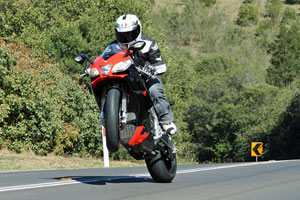
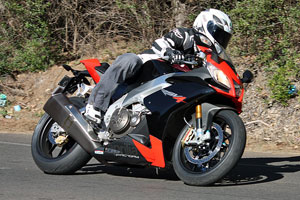
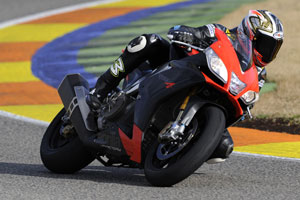
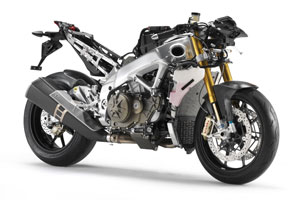
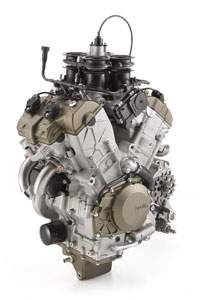
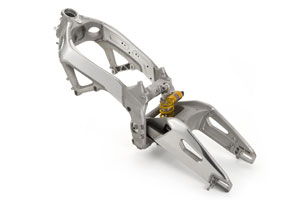
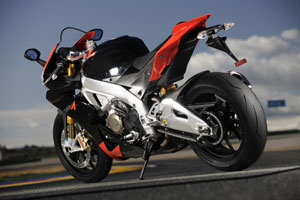





Newsletter